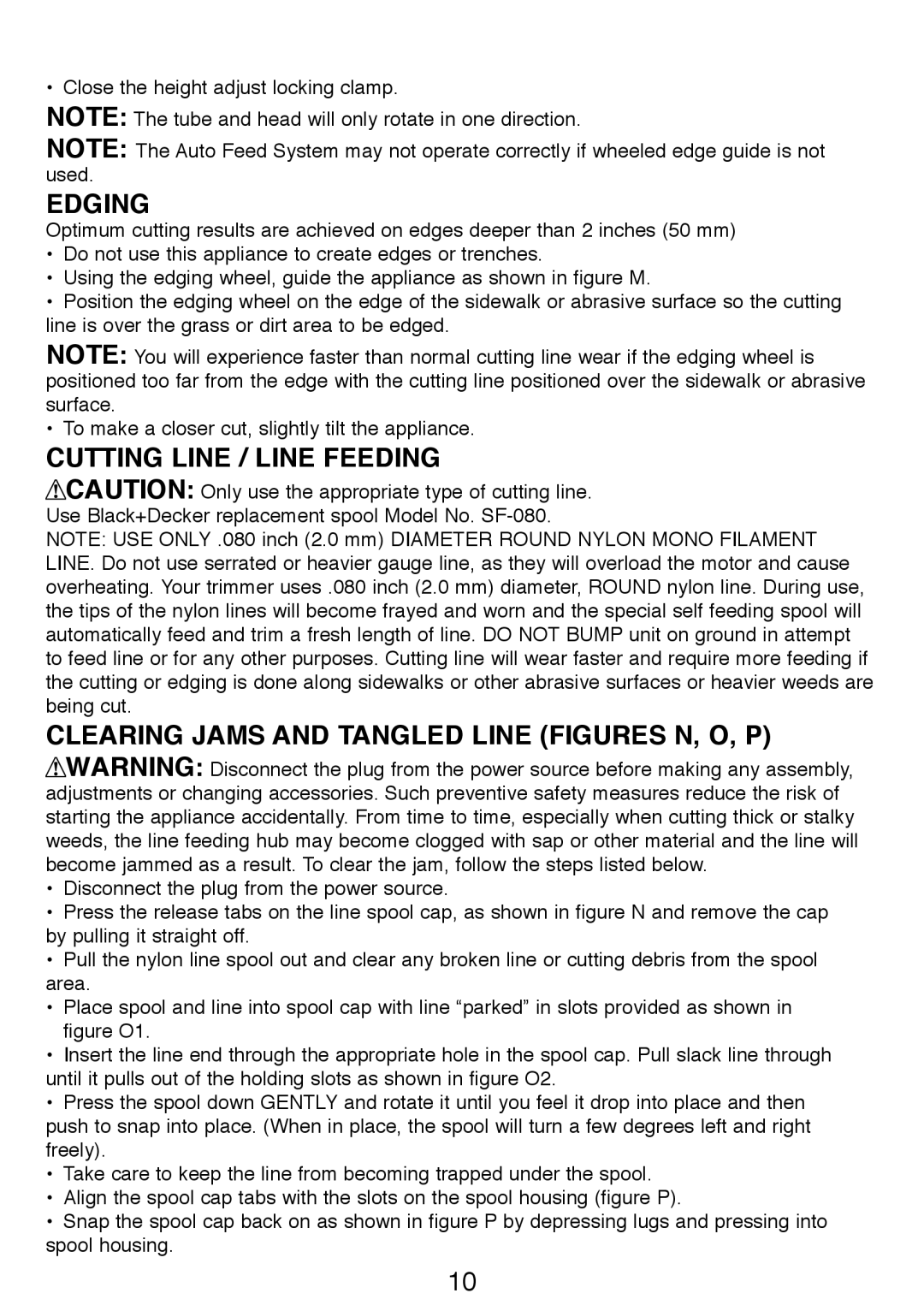• Close the height adjust locking clamp.
NOTE: The tube and head will only rotate in one direction.
NOTE: The Auto Feed System may not operate correctly if wheeled edge guide is not used.
Edging
Optimum cutting results are achieved on edges deeper than 2 inches (50 mm)
•Do not use this appliance to create edges or trenches.
•Using the edging wheel, guide the appliance as shown in figure M.
•Position the edging wheel on the edge of the sidewalk or abrasive surface so the cutting line is over the grass or dirt area to be edged.
NOTE: You will experience faster than normal cutting line wear if the edging wheel is positioned too far from the edge with the cutting line positioned over the sidewalk or abrasive surface.
• To make a closer cut, slightly tilt the appliance.
Cutting Line / LINE FEEDING
![]() CAUTION: Only use the appropriate type of cutting line.
CAUTION: Only use the appropriate type of cutting line.
Use Black+Decker replacement spool Model No.
NOTE: USE ONLY .080 inch (2.0 mm) DIAMETER ROUND NYLON MONO FILAMENT LINE. Do not use serrated or heavier gauge line, as they will overload the motor and cause overheating. Your trimmer uses .080 inch (2.0 mm) diameter, ROUND nylon line. During use, the tips of the nylon lines will become frayed and worn and the special self feeding spool will automatically feed and trim a fresh length of line. DO NOT BUMP unit on ground in attempt to feed line or for any other purposes. Cutting line will wear faster and require more feeding if the cutting or edging is done along sidewalks or other abrasive surfaces or heavier weeds are being cut.
CLEARING JAMS AND TANGLED LINE (figures N, O, P)
![]() WARNING: Disconnect the plug from the power source before making any assembly, adjustments or changing accessories. Such preventive safety measures reduce the risk of starting the appliance accidentally. From time to time, especially when cutting thick or stalky weeds, the line feeding hub may become clogged with sap or other material and the line will become jammed as a result. To clear the jam, follow the steps listed below.
WARNING: Disconnect the plug from the power source before making any assembly, adjustments or changing accessories. Such preventive safety measures reduce the risk of starting the appliance accidentally. From time to time, especially when cutting thick or stalky weeds, the line feeding hub may become clogged with sap or other material and the line will become jammed as a result. To clear the jam, follow the steps listed below.
•Disconnect the plug from the power source.
•Press the release tabs on the line spool cap, as shown in figure N and remove the cap by pulling it straight off.
•Pull the nylon line spool out and clear any broken line or cutting debris from the spool area.
•Place spool and line into spool cap with line “parked” in slots provided as shown in figure O1.
•Insert the line end through the appropriate hole in the spool cap. Pull slack line through until it pulls out of the holding slots as shown in figure O2.
•Press the spool down GENTLY and rotate it until you feel it drop into place and then push to snap into place. (When in place, the spool will turn a few degrees left and right freely).
•Take care to keep the line from becoming trapped under the spool.
•Align the spool cap tabs with the slots on the spool housing (figure P).
•Snap the spool cap back on as shown in figure P by depressing lugs and pressing into spool housing.
10
